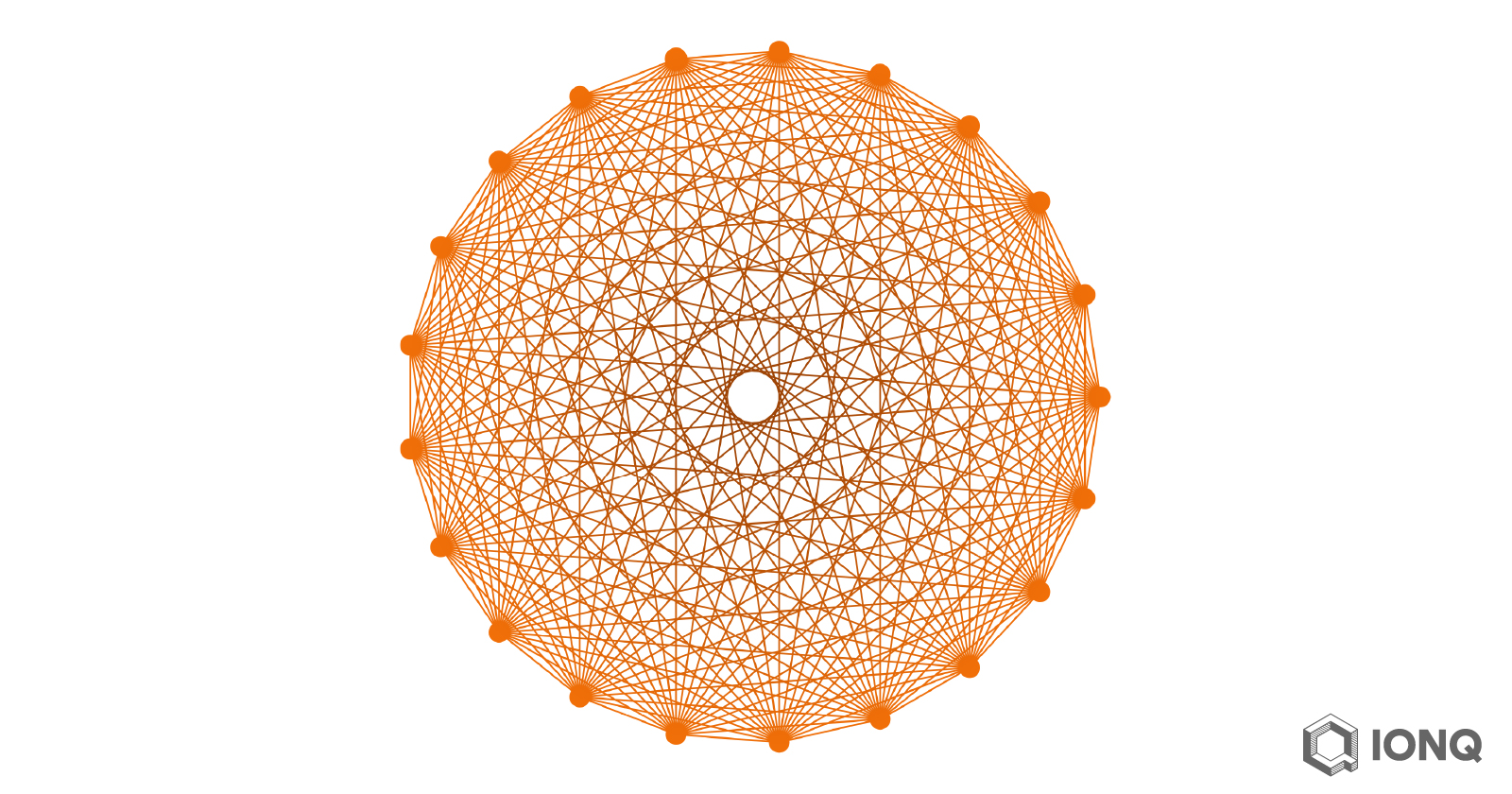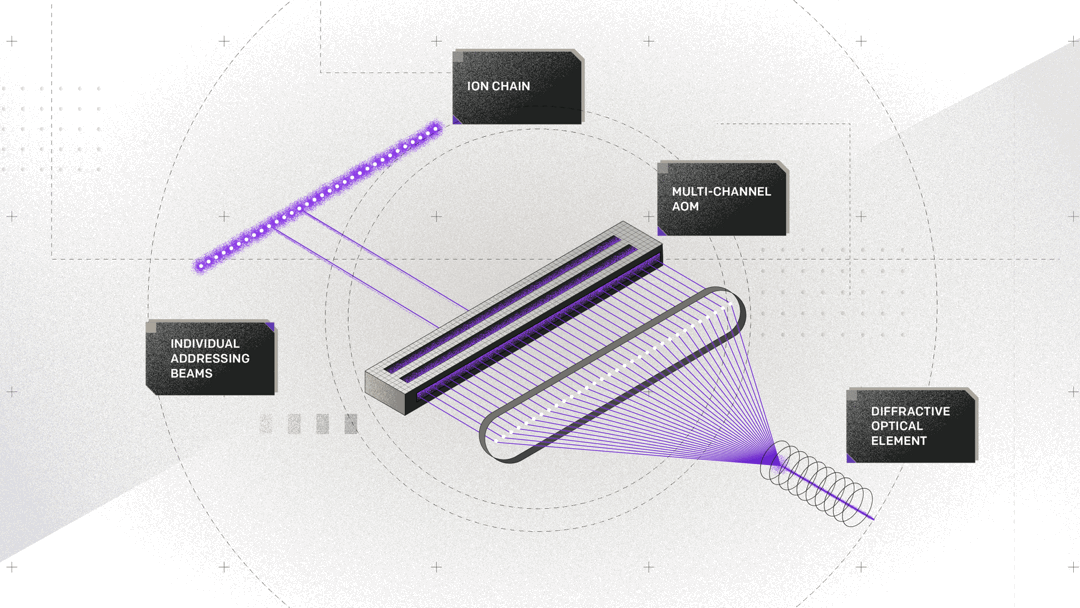This is part two of a series going deep on IonQ Aria, launched in 2022 as the world’s most powerful quantum computer. Part one is available here.

IonQ Aria features 21 fully-connected, high-quality qubits. All-to-all connectivity, as represented above, enables the system to entangle any qubit with any other qubit with no additional overhead.
IonQ’s Architectural Evolution
IonQ grew out of 15 years of collaborative research by Chris Monroe, a professor at the University of Maryland and now at Duke University, and Jungsang Kim, of Duke University. In 2013 they published “Scaling the Ion Trap Processor” in Science. It described their ideas for how ion trap technology could be scaled up and improved in order to create quantum computers capable of solving problems beyond the reach of any classical computer.
Crucially, they understood the need for a modular architecture, including the use of the "Quantum Charge-Coupled Device" or QCCD to shuttle ions around a single chip, and the use of modular photonic interconnects between chips. Both ideas were invented and developed by the IonQ founders. They also understood how important all-to-all connectivity would become in quantum computing applications and decided to design a system architecture that would include that feature at scale, and designed with this capability as a focus.
Together, they built their first prototype quantum computer at The University of Maryland. Launched in 2015, it used the same trapped ytterbium ions for qubits as IonQ Aria does. This early prototype only had five of them, but it ran the Deutsch–Jozsa algorithm with a 95% success probability and outperformed any other programmable quantum computer at the time.
Armed with this success, Kim and Monroe went about starting a company that could bring their vision to life much faster than a purely academic effort could. The first four IonQ systems were incremental improvements on the same basic approach, gradually improving qubit count and error rates with improved optics and electronics.
The last of these generations, IonQ Harmony, was the first to be made commercially available on the cloud to customers. It continues to be a popular choice among many users because of its competitive performance in the market, broad availability on all three major cloud services, and high reliability—it has run hundreds of thousands of jobs to date.
By the time it was time to design IonQ Aria, we were ready for a step-change. We took what we had learned from the systems up to Harmony, and used them to make several major architectural changes that we believed would dramatically improve system performance.
We made many small and large improvements to Aria that have contributed to its market-leading 20 algorithmic qubits. This blog post will highlight three. First is the use of its more advanced ion trap. We started out using general purpose ion traps fabricated at Sandia National Laboratories, developed through more than a decade of collaboration with IonQ’s founders. These are designed to support the research efforts at various universities and national labs on ion trapping experiments, and we stayed with them all the way until we designed IonQ Aria. The need to design and manufacture more advanced ion traps arose as the pace of our innovation and system requirements started to pick up, and some of the advanced features start to diverge from the typical needs of the general research community. Besides the Sandia traps, we are now designing and building our own in-house evaporated glass ion traps which are built specifically for the requirements of our quantum computers. These traps are designed to scale up to larger numbers of qubits without the loss of fidelity, and support multi-core quantum processor operation. They provide the stability necessary to operate with minimal recalibration, thereby maximizing uptime.
The second improvement is the operating environment for our qubits. Atomic ion qubits are isolated from the surrounding environment by operating them in ultra-high vacuum (UHV) chambers. By isolating them in vacuum, the ion qubits can be laser-cooled to near absolute standstill as required for high fidelity gates. The operation of our qubit chain can be disrupted by a collision from background molecules in the vacuum chamber from time to time, and the frequency of such interruption is limited by the levels of vacuum we can achieve. While the vacuum levels in IonQ’s Harmony systems are among the best one can achieve using conventional UHV technology, we experience disruptive collision about once or twice an hour. By improving the vacuum levels by several more orders of magnitude, one can completely eliminate these collision events and the ion chains will remain absolutely stable. In Aria, we improve the vacuum environment for ion qubits by what we estimate to be about a factor of 1,000 or better, so that the ion chains are retained for weeks at a time. This is accomplished by cooling the ion trap package down to low temperatures where most background gas molecules freeze out (this happens below about 10K).
The third improvement is in the arrangement of the laser beams used to drive the logic gates in our quantum computers. With improvements in the stability and alignment of the beams, we have been able to dramatically reduce the “crosstalk” errors, where the spillover of the beams affect neighboring ions in unintended ways.
These improvements all increase the reliability and stability of the quantum computer qubit chain, and reduce the errors in our quantum logic gates.

What’s In A Name?
Before IonQ Aria, we hadn’t given our previous quantum computers real names. Each was built with incremental improvements over the previous one and there was no single major step forward between those generations of technology. Considering its leap ahead both in terms of the ion trap, laser array and computational performance, IonQ Aria has a clear identity apart from anything else we have built thus far. This led us to start thinking about how to go about naming our products. Input was sought from stakeholders from all around the company, including the engineers and scientists who designed and built IonQ Aria. It so happens that some of those people are also accomplished musicians.
IonQ is introducing not only a new generation of quantum computers from IonQ, but also a naming scheme that reflects the substance of our computers and of our company’s culture.
Our ion traps contain strings of ions which are pushing against each other and produce motional modes. These modes behave harmonically, like a guitar string. What we do with the ions is like plucking a string at two points at once. Furthermore, waves are fundamental to both music and quantum computing – both require beautiful orchestration of waves with an end-goal in mind.
Thus, all of our quantum computers will be given musical names, starting with IonQ Aria. Our previous-generation 11 qubit system, currently just known as “qpu” or “11-qubit qpu” in most SDKs, will now be known as IonQ Harmony and will remain available on all three major cloud computing services as we monitor its usage and user satisfaction.
The Future
As our scientists and engineers spend more time with the system, we are working toward potentially improving IonQ Aria’s performance even beyond its current record-setting #AQ. Like a musician with a newer, finer instrument, we are discovering how to play more smoothly and get a better tone.
In addition to the select customers who are already using it in private beta, IonQ Aria will also be available via Microsoft’s Azure Quantum cloud service. Early access can be made available to more customers by request. This is an opportunity to start working with the world’s best quantum computer. We can also provide advice and assistance from some of the world’s top quantum physicists and quantum software engineers at IonQ who can help you turn your organization’s big questions and problems into quantum algorithms and software that will scale up for more impactful applications as we build even more powerful and useful computers in the future.
To discuss getting access to IonQ Aria for your organization, contact us using the form below.